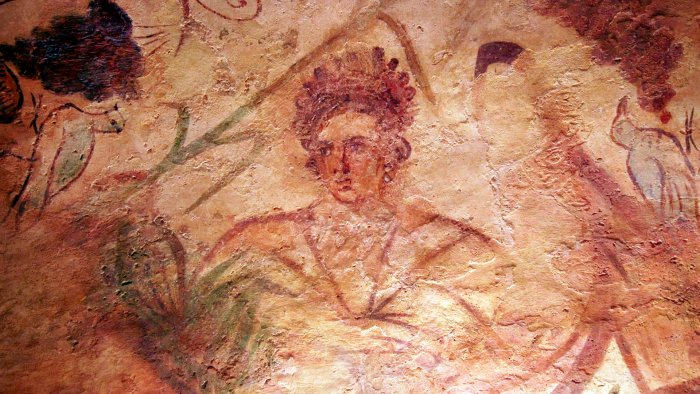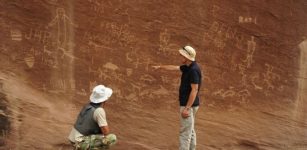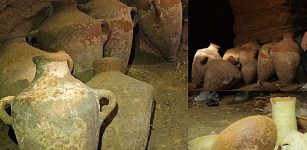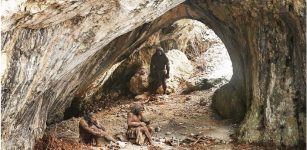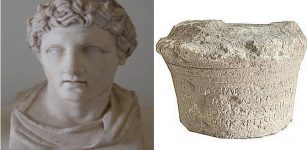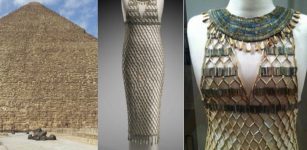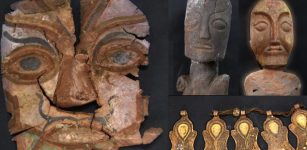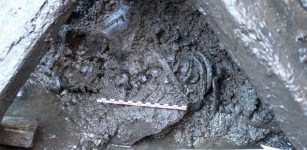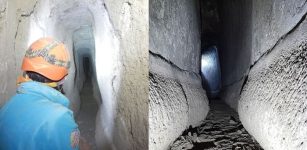Never-Before-Seen Roman-Era Wall Paintings Discovered In Ashkelon Revealed To The Public For The First Time
Jan Bartek - AncientPages.com - Two Roman-era vaulted tombs, dating back at least 1,700 years, have been discovered in Ashkelon, Israel. These tombs feature exceptional wall paintings, which are uncommon finds in the region. The artwork depicts Greek mythological figures, people, plants, and animals. This ancient artwork is now being revealed to the public for the first time.
The tombs are located near Ashkelon's marina, in a public area between residential towers. This discovery is part of a collaborative effort between the Ashkelon Municipality and the Israel Antiquities Authority to integrate the city's historical assets into public spaces.
A figure of Greek mythology’s goddess Demeter appears on the structure’s ceiling. Credit: Israel Antiquities Authority
The site, which was previously neglected, has been transformed into a public garden that houses the two tombs. This development aims to benefit residents and visitors by providing access to these remarkable historical structures.
The wall paintings within the tombs are particularly significant due to their rarity in Israel. They offer a unique glimpse into the ancient world and provide valuable insights into Roman-era art and culture in the region.
"Ashkelon is one of the world’s oldest cities, and as we shape and design the city's future, we ensure a place of honor to its glorious and rich past. In recent years we have made a real revolution in the realm of historical site preservation. We made sites accessible to the city's residents and to the general public, and then organized events and produced educational, cultural and touristic programs with the aim of connecting the city's history to its present.
Dr. Elena Kogan-Zehavi, Israel Antiquities Authority, who uncovered one of the tombs about 30 years ago, standing in the tombs after their preservation. Credit: Israel Antiquities Authority
This is the appropriate moment to thank Deputy Mayor Miri Altit for her comprehensive professional work in this endeavor and the Israel Antiquities Authority for this cooperation of such immense importance, helping us position Ashkelon as Israel’s City of Antiquities," Ashkelon Mayor Tomer Glam said in a press statement.
The archaeological site in question was discovered in the 1930s, approximately 300 meters from the shoreline, consisting of a sand-filled vaulted tomb. A British expedition conducted the excavation of the tomb structure, dating it to the early 4th century C.E. The structure comprises a hall with four adjacent burial troughs. The passageway is adorned with a series of paintings, notable for their quality and craftsmanship, including depictions of Demeter, the Greek mythological goddess associated with earth and grain.
The artistic representations encompass botanical elements such as vines, grape clusters, leaves, and branches. Additionally, the paintings feature nymphs, mythological figures connected to nature, portrayed with lotus plant wreaths adorning their heads and holding pitchers from which water flows. The imagery also includes diverse fauna, such as birds and deer, and scenes of children harvesting grapes and collecting them in baskets. A figure playing Pan's flute is also depicted, along with numerous other images, most notably the head of Medusa the Gorgon—a monstrous female visage with serpentine hair. In Greek mythology, her gaze was believed to petrify those who looked upon her.
The mythological Medusa—Gorgon figure in the painted tomb. Credit: Israel Antiquities Authority
Furthermore, another vaulted and decorated tomb, originally located at a different Ashkelon site, was relocated to the public garden in the 1990s for preservation purposes. This tomb, unearthed during excavations led by Dr. Elena Kogan-Zehavi of the Israel Antiquities Authority, dates to the 2nd century CE. The central hall of this structure features walls adorned with polychromatic paintings depicting human figures, avian species, and other representations from the animal and plant kingdoms. Surrounding the hall are vaulted loculi, within which lead coffins were discovered, embellished with human, animal, and vegetative motifs.
The conservation and restoration work of the Israel Antiquities Authority conservators. Credit: Israel Antiquities Authority
Recently, experts from the Israel Antiquities Authority preserved ancient structures and decorations in Ashkelon through a complex conservation process. Mark Abrahami, head of the art conservation branch, explained that Israel's humid climate rarely preserves ancient wall paintings. The process involved careful treatment to repair damage from time and weathering. Ashkelon Municipality has invested in developing the city's ancient sites in collaboration with the Israel Antiquities Authority. Projects include a public park featuring an ancient industrial site, conservation of mosaics, and upgrades to the sarcophagus courtyard. The upcoming opening of the public garden will allow visitors to admire these rare paintings and learn about Ashkelon's fascinating history.
A figure holding a peacock, after Israel Antiquities Authority conservation work. Credit: Israel Antiquities Authority
Recently, experts from the Israel Antiquities Authority preserved ancient structures and decorations in Ashkelon, one of the first cities in Israel, through a complex conservation process. Mark Abrahami, head of the art conservation branch, explained that Israel's humid climate rarely preserves ancient wall paintings.
Dr. Elena Kogan-Zehavi standing in the tombs after their preservation. Credit: Israel Antiquities Authority
The process involved careful treatment to repair damage from time and weathering. Ashkelon Municipality has invested in developing the city's ancient sites in collaboration with the Israel Antiquities Authority.
See also: More Archaeology News
Projects include a public park featuring an ancient industrial site, conservation of mosaics, and upgrades to the sarcophagus courtyard. The upcoming opening of the public garden will allow visitors to admire these rare paintings and learn about Ashkelon's fascinating history.
Written by Jan Bartek - AncientPages.com Staff Writer

